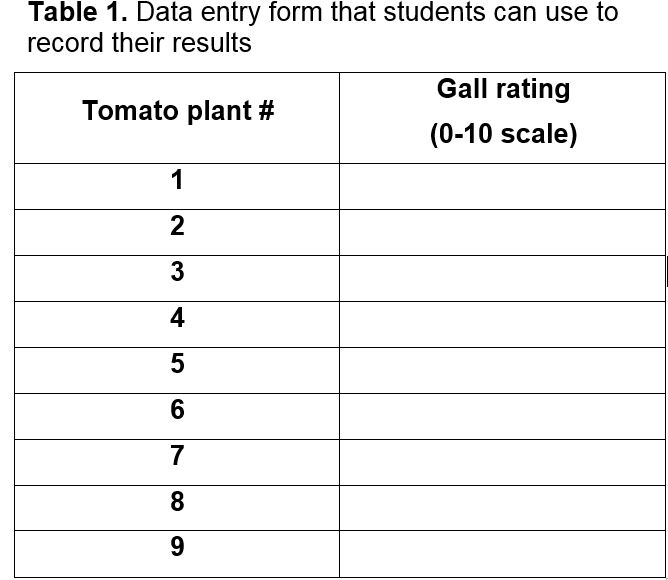Materials
-
Nine plants per class. Three replicate plants infected with varying numbers of
root-knot nematodes
-
Scalpel
-
Dissecting needle
-
Forceps
-
Petri dish
-
Nematode pick or Pasteur pipettes
-
Microscope slides and cover glasses
-
Compound microscope
-
Dissecting microscope with incident and transmitted light sources
See Instructors Note #2 — Preparation of materials
Procedure
Rating of Root-Knot Severity
Examine each of the plants and assign a rating from 0-10 to each plant based on your estimate of the percentage of the root system that is galled (0=0% galled, 10=100% galled). Use Table 1 to complete this activity.
Examination of Root-Knot Signs
Remove a single gall and place into a petri dish with water (nematodes are aquatic organisms and dry out easily). Examine the gall under a dissecting scope with incident light for egg masses. Using a scalpel and forceps, dissect open the gall and look for nematodes using transmitted light. Adult females are easily ruptured. To remove an adult female, gently press on the tissue surrounding her with forceps. Using either the provided nematode pick or a Pasteur pipette, transfer the nematodes to a microscope slide with a small amount of water. Gently apply the cover slip and examine the specimens with a compound microscope and a 40X objective (Riley 2003).
Observations and Question for Students
Questions at the Start of the Laboratory:
- Describe the life cycle of the root-knot nematode
- What are the symptoms and signs of root-knot nematode infection?
- What stages of nematodes do you expect to see under the compound microscrope?
Data Collection and Questions at the End of the Laboratory:
Use the provided table (Table 1) to assign a gall rating (0-10) for each plant.
Share your ratings with your classmates and work together to answer the following questions:
- Did your ratings match those of your classmates exactly? If not, why?
- Propose a method to analyze the data you collected.
- What are the advantages and disadvantages of using a rating system
- Design an alternative method to assess root-knot nematode damage
- Sketch and label the nematode you observed under the compound microscope. Include in your sketch the developmental stage you examined.
See Instructors Note #3 — Explanation of Expected Results
Table

Literature Cited
Barker, K. R., Todd, F. A., Shane, W. W., and Nelson, L. A. 1981. Interrelationships of
Meloidogyne species with flue-cured Tobacco.
Journal of Nematology. 13:67–79.
Bridge, J., and Page, S. L. J. 1980. Estimation of Root-knot nematode infestation levels on roots using a rating chart.
Tropical Pest Management. 26:296–298.
Hussey, R. S., and Barker, K. 1973. A comparison of methods of collecting inocula of
Meloidogyne spp., including a new technique.
Plant Disease Reporter. 57:1025–1028.
Mitkowski, N. A., and Abawi, G. S. 2003. Root-knot nematodes.
Plant Health Instructor. On-line doi:10.1094/PHI-I-2003-0917-01
Riley, M. 2003. Basic microscopy - An important skill for plant pathologists.
Plant Health Instructor. On-line doi: 10.1094/PHI-I-2003-0130-02
Zeck, W. 1971. A rating scheme for field evalutation of root-knot nematode infestations.
Pflanzenshutz-NachrichtenBayer. 24:141–144.
